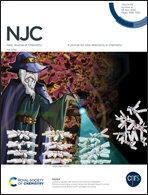Indium doped ZnO nanorods for chemiresistive NO2 gas sensors†
Abstract
Semiconducting metal oxides are promising candidates in gas sensor technology, enchanting the scientific community with their remarkable ability to detect various gases at moderate operating temperatures. It is a well-known fact that the gas response of metal oxide and doped metal oxide-based sensors primarily depends on the aspect ratio of the morphology and the number of defects found in them. Hence, the purpose of the present investigation is to enhance the gas response of the zinc oxide (ZnO) nanorod arrays by doping the indium (In) with various concentrations in the zinc oxide matrix. The doping concentration of ‘In’ varied from 1 to 3 volume percentages by using the reflux method. The physico-chemical properties of the indium doped zinc oxide (IZO) samples were investigated by X-ray diffraction, field emission scanning electron microscopy, photoluminescence spectroscopy, X-ray photoelectron spectroscopy, etc. The IZO samples reveal a wurtzite hexagonal crystal structure. The FESEM image shows a nanorod-like morphology with an average diameter of 100 nm and an average length of 2 μm. The roughness of the IZO samples was studied by using atomic force microscopy. The photoluminescence study revealed that the defect sites can be increased by altering the interstitial properties or by external additives. Herein, we report on the formation of signatures emanating from defect sites. The IZO samples show the enhanced gas sensing response towards NO2 gas at 175 °C operating temperature as compared with undoped ZnO. Also, the lowest detection limit for NO2 gas was found to be 5 ppm at optimized temperature, which is the highest detection limit at a low operating temperature for IZO samples. Notably, the doping of ‘In’ in ZnO substantially improves the gas detection capability.



 Please wait while we load your content...
Please wait while we load your content...